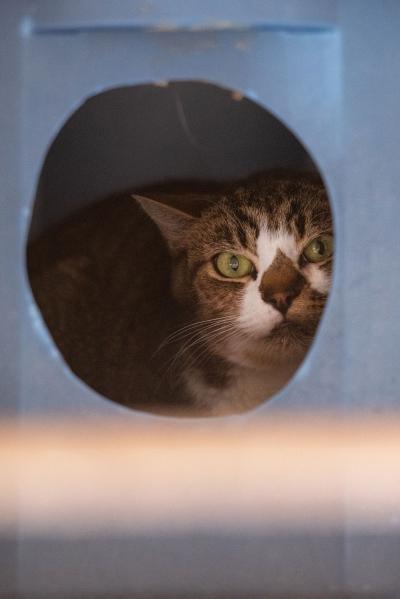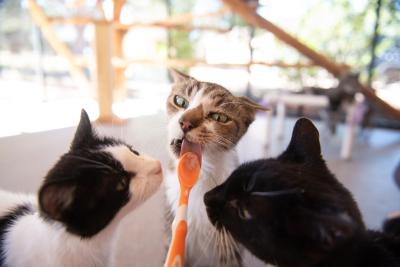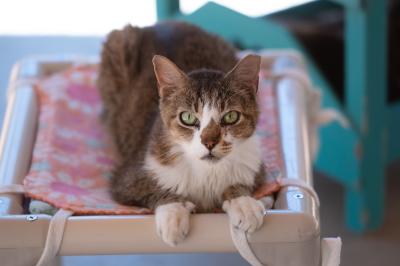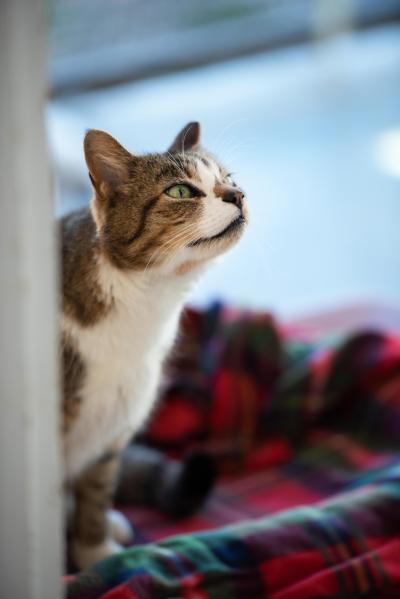Once-scared cat overcomes much to enjoy golden years

Forest the cat’s whole world was upended when his person passed away. He’d lost the home he’d known for so long, and though he was soon headed for safety at Best Friends Animal Sanctuary, the change was a lot to handle. Everything about this home-between-homes was new: new sounds, new smells, new people, new cats. So it’s understandable that he was, at first, more than a bit overwhelmed. As soon as he could, Forest scrambled up to the highest hidey-hole he could find, hunkered down, and stayed there.
In many cases, shy and scared cats just need a bit of time to settle in and get comfortable before they’re ready to make their grand re-entrance and shine. Pets like Forest — those who need that extra time before they move into new homes of their own — are the reason Best Friends made it a goal for all shelters to reach no-kill by 2025. And Forest, it turned out, would need a whole lot of extra time (and treats). But the gregarious tabby cat who’d emerge after all the TLC would be well worth it.

Coming down from the rafters
For a while, Forest kept to himself up in his safe spot, high above the floor where many of his feline roommates happily greeted caregivers and volunteers. He didn’t have any interest in snuggling up with the other cats in their comforting cuddle puddles and would only venture down from his perch when he thought no people were around to spot him. He was the mysterious flash of green eyes in the shadows of a tucked-away cat bed and the rush of white paws jumping just out of sight as you turned your head.
Before too long, Forest did start making feline friends — a shy newcomer here, a persistent long-time roommate there. He started showing up in purring piles of cats and, of course, disappearing from them as soon as he heard a door open. But it was a good start, a good sign that he’d started getting comfortable.
The next step, then, was helping Forest open up to humans. And the way to Forest’s heart, caregivers learned, was through his stomach. Party Mix, Temptations, Churus, and even tasty baby food got his eyes saucer-sized and his nose a-twitching. For his favorites, he’d stretch forward out of his hiding spot even with someone watching — though he wasn’t above a quick paw swat if he felt they were taking too long to place their offerings and leave.
Seeing the opportunity to really help guide Forest out of his shell, caregivers made it their mission to spend time with him each day. They offered treats and climbed up on a ladder just to talk quietly with him at his level and let him know that he could feel safe even with them there. If he wanted to grab a treat and run, that was fine. If he wasn’t interested in going near their hands, it was up to him.
Bit by bit, those little moments helped Forest gain confidence. He’d learned that if someone was coming through the door, they probably had a treat in hand. They weren’t going to chase him or do anything scary — just talk, hang out, and give him a snack. And that was OK. More than OK, in fact. That was pretty great.
Instead of scrambling up and away when a door opened, now Forest was hopping down to join the other excited feline greeters at visitors’ feet. When he was feeling especially brave (and had a kitty comrade at his side), he might even lean into a head scratch or two.
But just as Forest had found his footing and was getting into his role as a newly emerged social butterfly and familiar friendly staple of his room, the soon-to-be senior cat ran into a new hurdle. Forest became sick, and his newfound friends worried about what would become of the bright future he finally seemed ready for.

Overcoming tummy troubles
For all his love of food, caregivers noticed Forest was losing weight — fast. He developed a bad case of diarrhea, which he sometimes could not make it to the litter box for, even if it was very close.
He tested positive for giardia, a parasite that causes diarrhea and other intestinal issues. But even after being treated for that, Forest was not improving. He was gulping down water as fast as could be, but the bowls of special wet food that contained his medicine needed extra treats on top to convince him to eat.
Forest went for checks with the veterinary team, where they tested for several possible causes and tried different medications in the hopes of curing his tummy troubles. A switch in diet seemed to help with one problem, only for him to become nauseated. It was a rough time all around — not least for little Forest, whose stomach, it appeared, could not be calmed.
[New digs, new diet help senior cat manage chronic tummy troubles]
At one point Forest was doing so poorly, despite all attempts to make him feel better, that caregiver Matt Owens says, “We weren't sure he would make it.” But then, a trip to a specialist in Las Vegas found the answer: Forest’s digestive tract was playing host to a nasty bacterial infection called campylobacter. He’d need a lot of support and close care to start feeling better, but caregivers were ready for it.
Antibiotics, an even more specialized diet, regular baths and ointment to clean and soothe his hind end, and subcutaneous fluids became the order of the day. It was a lot of hands-on work for a cat who’d once been so wary of people, but his human friends were careful to go slowly and be as gentle as they could with the treatment.
For several months, Forest was closely watched and cared for through ups and downs, downs and ups, until finally his health made a turn for the better and kept going.
“Forest surprised everyone by bouncing back and making a full recovery,” Matt says. “He was ever so happy to resume his favorite pastimes: munching on all the treats, snuggling with his buddies in a fuzzy warm cuddle puddle, and gazing at you with his big bright green eyes.”

Forest, free to enjoy life
These days, the 10-year-old tabby is doing better than ever. He’s out and about, swaggering up to visitors to check for treats like nothing was ever wrong. He’s got a spring in his step and sometimes a little bubble on his arm from getting his fluids (after running his caregivers around the room for some exercise first). And all in all, Forest is happy as can be.
Now it’s time for his next adventure: getting matched with a family who will make sure his golden years are as full of yummy treats as they are patience and love.

Let's make every shelter and every community no-kill by 2025
Our goal at Best Friends is to support all animal shelters in the U.S. in reaching no-kill by 2025. No-kill means saving every dog and cat in a shelter who can be saved, accounting for community safety and good quality of life for pets.
Shelter staff can’t do it alone. Saving animals in shelters is everyone’s responsibility, and it takes support and participation from the community. No-kill is possible when we work together thoughtfully, honestly, and collaboratively.






